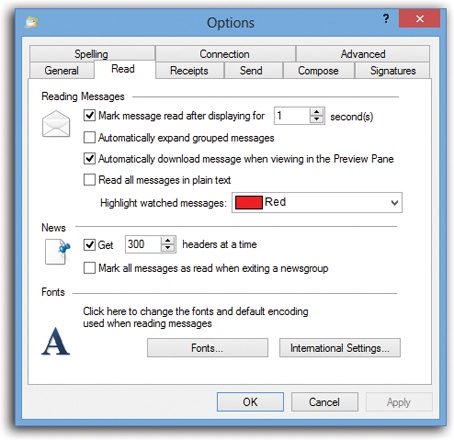The World of Mail Settings
Mail has enough features and configuration options to fill a very thick book. You can see them for yourself by choosing File→Options→Mail. Here’s a brief overview of some of the most useful options (Figure 16-16).

Figure 16-16. The Options dialog box has 10 tabs, each loaded with options. Most tabs have buttons that open additional dialog boxes. Coming in 2014: Windows Mail Options: The Missing Manual.
General Tab
Most of the controls here govern what Mail does when you first open the program. Take note of the options to connect automatically; you can opt to have Mail check for messages every few minutes and then use the drop-down list to say how, and whether, to connect at that time if you’re not already online.
Read Tab
Use these options to establish how the program handles messages in the inbox. One of these options marks a message as having been read—changing its typeface from bold to nonbold—if you leave it highlighted in the list for 1 second or more, even without opening it. That’s one option you may want to consider turning off. (This tab is also where you choose the font you want to use for the messages you’re reading, which is an important consideration.)
Receipts Tab
You can add a return receipt to messages you send. When the recipient reads your message, a notification message (receipt) is emailed back to you under two conditions: if the recipient agrees ...
Get Windows 8.1: The Missing Manual now with the O’Reilly learning platform.
O’Reilly members experience books, live events, courses curated by job role, and more from O’Reilly and nearly 200 top publishers.

